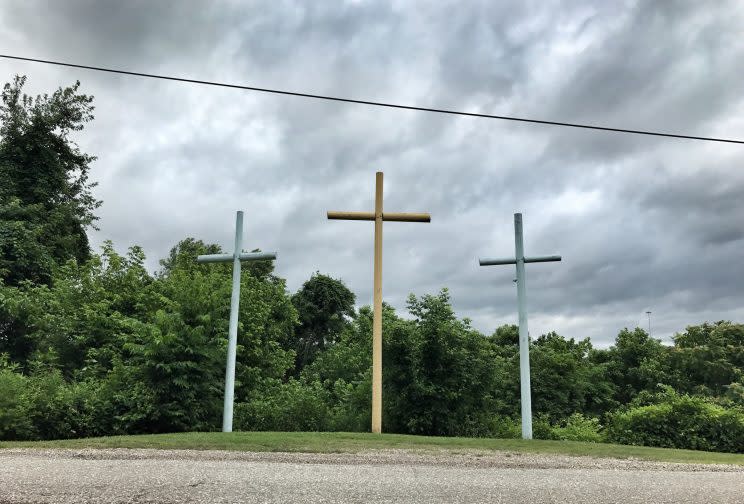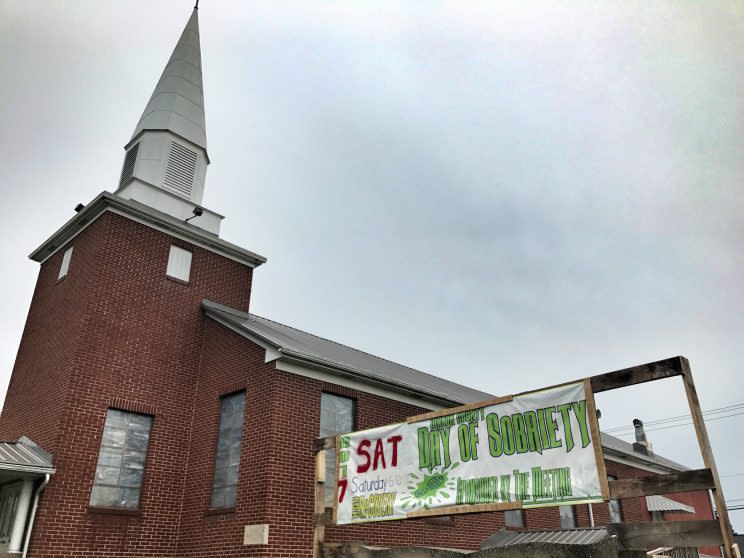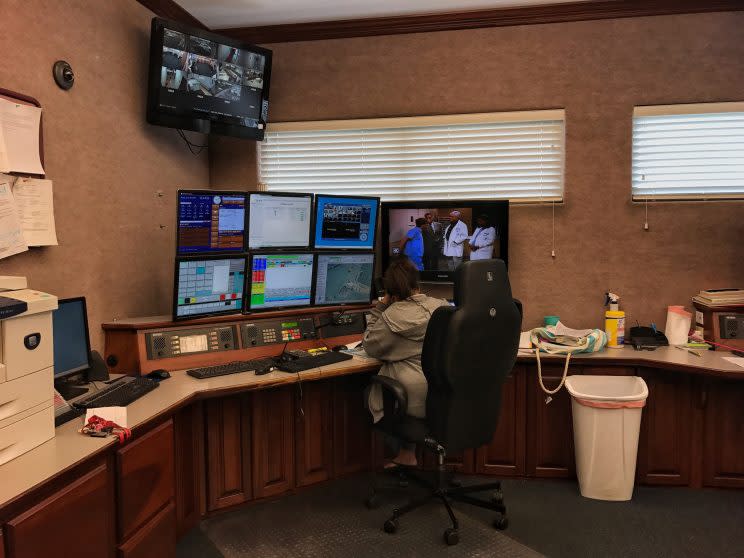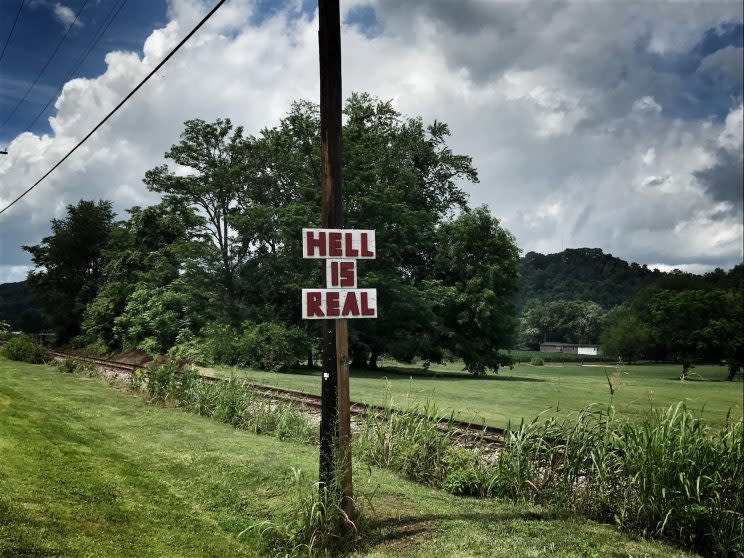Ravaged by opioids, a rural W.Va. community fears gutting of Medicaid

POINT PLEASANT, W.Va. — A few months ago, Dylan Handley and another paramedic were responding to a medical alert here in rural Mason County when he noticed one of the back tires of their ambulance had gone flat. When the call turned out to be a false alarm, they pulled the vehicle over and were getting ready to change the tire when a man drove up and offered to help.
One of his employees was a mechanic and could change the tire quickly, the man said. And as promised, the mechanic was soon on the scene, lifting up the ambulance with a forklift and removing the tire so quickly that, as Handley recalled, “It was like watching a NASCAR pit stop.”
After expressing deep gratitude, Handley and his colleague were soon back on their way, but within minutes, a 911 call came from the other side of the county — a call they likely would have missed had they been stuck fixing the flat on their own. When they arrived, they found a situation that has become all too familiar here in recent years: A young girl, her breath so faint that her skin had turned blue, passed out from an apparent drug overdose.
Mason County is the epicenter of an opioid epidemic that has overtaken much of West Virginia. So Handley did what he and his team at the Mason County EMS now do two or three times a day, on average. He administered oxygen and gave her a shot of Narcan, an opioid blocker. Within minutes, the girl was awake and talking, apologizing profusely for what she had done. She insisted she had been clean for months, but had slipped up — an line EMTs hear a lot in Mason County. As she gave Handley her driver’s license so he could fill out paperwork, she thanked the paramedics profusely for saving her life. But like many overdose patients here, she declined to be taken to the hospital. She felt fine and didn’t want anybody else to know what had happened. She insisted she would be OK with no further treatment.
When he looked at the last name on the license, Handley suddenly froze. “Who is your dad?” he asked the girl. When she told him, he couldn’t believe it. Her father was the mechanic who had just fixed their flat tire. “I know she would have died had he not helped us fix that tire,” Handley recalled. “I told her that she didn’t have to thank us but that she’d better get on her knees and thank God and then go home and thank her dad, because if it hadn’t been for him, we would have still been stuck there on the side of the road, and we wouldn’t have gotten to her in time.”

When people ask Handley what it’s like being a paramedic in a county awash in opioids, where drug overdoses have become more prevalent than murders, car crashes and even heart attacks, he tells that story — a tale so unbelievable, he admits he probably wouldn’t believe it had he not been there to see it for himself.
But for Handley, who heads up the Mason County EMS and has worked as a medic in the region for 20 years, the story encapsulates everything about the drug epidemic that has overwhelmed his hometown: How it has touched everything and everybody in this small county of roughly 27,000 people and how he and his team, as first responders, are on the frontlines every day, racing to keep people alive against a scourge that seems to have no end.
“People have this idea of what they think someone who abuses drugs is, that it’s some deadbeat. But every day we are treating people we know, people you see in church or that you went to high school with or are honor students from good families,” he said. “You’d look at them and never know. But nobody has been spared. … And the worst part is that you see them again and again. They get caught up in the grips of this thing, and it consumes them. They can’t get out.”
In the past 12 months, Handley and his team have responded to more than 150 calls related to drug overdoses — roughly double the number of calls reported between June 2015 to June 2016, the agency’s reporting year. According to the West Virginia Health Statistics Center, which monitors the state’s vital records, 13 people died in Mason County from drug overdoses in the calendar year 2016. That was more than double the six fatalities reported in 2015 and one of the highest per capita drug death rates in the state of West Virginia, which reported 879 overdose deaths overall — one of the highest totals in the nation.
If there is an upside to what has happened to Mason County, and Handley is always desperately looking for one, it’s that more people haven’t died. But many here wonder how much longer than can last. As the crisis grows, the opioid war has taken a major financial toll on rural health care providers, including the local hospital and the Mason County EMS, which receives little public funding and has been barely making ends meet. It pays the bills largely through patient insurance — which in this mostly poor, rural area is Medicaid, a program that could see massive cuts under the health care bill championed by Senate Republicans anxious to deliver on their campaign promise of repealing the Affordable Care Act.

Already on the financial brink because of reimbursement cuts, the Mason County EMS is also bracing for potential disaster on another front. In September, a state grant that has been reimbursing the service for its use of Narcan, the opioid-countering drug credited with saving scores of lives here, is set to expire with no prospect of renewal. Just $12 a vial two years ago, Narcan has quadrupled in price to nearly $50 a shot amid high demand. “Price gouging,” Handley called it. And with some addicts now switching from opioids to heroin laced with synthetic drugs, which is cheaper than prescription drugs and dangerously stronger, some overdose victims in Mason County are now requiring as many as five shots of Narcan to be revived. While Mason County hasn’t run out of the anti-overdose drug yet, other parts of the state have. That’s led to complaints that addicts are abusing the drug as a “get out of jail free card,” as one local official here put it, continuing to use and assuming someone will always be there to “Narcan them” out of harm’s way.
Between the Senate health care bill and the end of the Narcan grant, Handley frets about a looming disaster for the Mason County EMS, one of the few rural ambulance services left in the region. In West Virginia, more than 40 ambulance services across the state’s 55 counties have shut down in recent years because of financial troubles, and Handley believes Mason County could be next. “If there are more Medicaid cuts, and no other help, this would be catastrophic for us,” he said last week. “I don’t know if we could survive. We are talking about a potential situation where people would call 911, and there would be no one to help, whether it’s an overdose or a heart attack or a car accident or a broken hip. There would be no one. Can you imagine?”
It’s hard to ignore the politics at play. Mason County was unquestionably Donald Trump country, a remote area where residents strongly identified with his populist message and appeal to Americans who had been left behind by economic progress. But the Republican effort to gut Medicaid may be stirring the first real signs of disaffection with Trump among the supporters most responsible for his unlikely path to the White House.
Mason County is located on the far western side of West Virginia, about an hour north of Huntington. It is nestled deep in a winding, hilly landscape that runs along the Ohio River in purest Appalachia. It used to be a place teeming with industry, like farming, steel and coal mines and even a flourishing lumber industry that, among other things, was the primary supplier of timber for wooden ships long before the arrival of steel vessels and barges. It is an area that remains deeply committed to evangelical Christianity, with countless roadside crosses and tributes to Jesus Christ, including signs admonishing people to “Love Thy Neighbor.”

During World War II, the area was home to military facilities that manufactured and stored TNT — ordnance that was kept in concrete igloos that still dot the landscape outside Point Pleasant. When the facility was closed in 1945, the “TNT area,” as it is known, became the subject of local legend; residents reported seeing what they described as a large, winged figure haunting the woods. The red-eyed bird man was soon christened “the Mothman,” a celebrated figure in local folklore that became the subject of a book as well as a 2002 film starring Richard Gere that attracted tourists who were curious about the supernatural. According to local lore, the figure is only seen when things are about to get really bad, and after a decades long absence, sightings of the Mothman have suddenly started up again, beginning last November. Some local believers openly wonder if it was a foreshadowing for the rocky few months to come.
The area has been in steady decline for a few decades. Hard hit by factory and plant closures that have plagued other Rust Belt states, the unemployment rate in Mason County has been steady at around 12 percent for years — though it could be much higher, since many residents long ago gave up looking for jobs, a depression (both economic and psychological) that many blame for the rise in drug abuse.
One of the biggest blows came in 2015 when the Philip Sporn power plant, located in the northern part of the county in New Haven, closed. The coal-fired plant had struggled for years amid the rise of natural gas, reducing its workforce from a high of 350 in the 1970s to just 70 workers. Two years ago, the owner, Appalachian Power, announced it would close the plant because it did not comply with new clean-air rules passed by the Obama administration, a decision that did not win the president many fans.
So when Trump came along, campaigning on a message of dialing back Obama-era regulations on the coal industry, creating jobs and helping what he called “the forgotten people” in America who had not enjoyed the economic resurgence experienced by other parts of the country, people here strongly latched on to his message. Add to that his promises of doing more to stave off the opioid crisis, and Mason County was firmly Trump country. Though most voters in the county are registered Democrats, Republican presidential candidates have tended to triumph here, winning with a little over half the vote. But last November, Trump won 75 percent of the vote — one of the highest percentages in a state that strongly supported his unlikely candidacy — and people here have been anxious to see him deliver on the promises he made to the region.

These days, support for Trump here is somewhat muted compared to even a few months ago. Driving around the county on a recent Friday, nobody wanted to own up to backing Trump last November. In the parking lot of the local Dairy Queen in Point Pleasant, a woman who had a “Make America Great Again” bumper sticker on her car demurred when asked about the president. Why didn’t she want to talk? The day before Senate Republicans had unveiled their version of health care reform, which like the House bill passed in the spring, detailed massive cuts to Medicaid. “I like Trump, but I guess I am disappointed,” the woman, who declined to give her name, said. “I don’t think Obamacare is perfect, but I don’t think throwing the whole thing out is smart either. That hurts us here. What are people going to do?”
It’s a question that has vexed elected officials, including the state’s junior senator, Shelley Moore Capito. The centrist Republican backed Trump last year and has been critical of Obamacare but has also been cagey about Republican efforts to repeal the ACA because of how it would impact her constituents in a state that has strongly benefited from the law.
According to U.S. Census Bureau numbers cited by Politifact, the number of uninsured individuals between the ages of 18 and 64 went from an average 21 percent between 2008 and 2013 to 9 percent in 2015 in West Virginia after the ACA — one of the biggest declines in the country.
West Virginia was among the 31 states took advantage of a provision in the ACA that allowed states to expand Medicaid to grant coverage to millions of low-income adults who could not otherwise afford health care. But the Senate bill would gut Medicaid — cuts that could be potentially devastating to West Virginia and especially its efforts to combat the opioid crisis.
Not only are rural health care providers heavily dependent on Medicaid, many of those covered by Medicaid are the ones being treated for drug abuse. According to the West Virginia Department of Health and Human Resources, roughly 50,000 of those who are covered through the Medicaid expansion were treated for substance abuse last year — a number many state officials expect to increase amid a drug crisis that appears to be getting worse by the day.
After Senate leaders delayed a vote on the bill, Capito announced she was against the current legislation as it is written. But she continues to be seen as a pivotal figure in the debate, a swing vote who has been lobbied intensely by people on both sides of the issue.

Among those who have lobbied her — or tried to — has been Handley, who says he has repeatedly called Capito and others in the West Virginia congressional delegation to warn that EMS could be forced to close if the proposed cuts to Medicaid are approved. “It feels like it falls on a deaf ear,” he said. “They all like to get on MSNBC and Fox and talk about how they’re there to help their constituency, but I think when you get down to the brass tacks of it, if they would look at their constituency, they’re not doing a very good job.”
The Mason County EMS offices are located just outside Point Pleasant, on a patch of land next to a mobile home park not far from the banks of the Ohio River. In one building is the county’s emergency operations center — a building built after 9/11 that is constructed to withstand bombs and severe weather. But it’s the silent creep of drugs that has proven to be the more terrorizing element here, the one that threatens to break the back of health care.
As head of the EMS, Handley has an alert on his phone for every 911 call that comes in to the dispatch center. Though he’s consumed with budgets and trying to find ways to pay the bills, including the $80,000 a month payroll he has for his small team of paramedics, Handley still often goes out on calls— determined to see for himself what his staff is coming up against.
Positioned right along the Ohio border, Mason County is believed by some to be the major transportation point into West Virginia for drug dealers bringing their product into the state. And Handley can often tell when they arrive, as overdose calls begin to dot the map along the key highways around the county — north towards New Haven and south towards Huntington and Charleston.
The service has four ambulances available at any given time, each staffed by two paramedics, which would seem to be enough for a small area like Mason County. But with the uptick in overdoses, Handley worries constantly about the nightmare scenario where they can’t respond in time. In recent months, they have come close to being overwhelmed. In April, a bad batch of heroin prompted 14 overdose calls in less than five hours, prompting Handley to call on help from neighboring counties. Miraculously, nobody died, thanks in large part to Narcan and quick thinking from the county’s emergency operations center which posted a message on Facebook warning people about the bad drugs — a social message that appeared to work since the overdose calls suddenly stopped.

Just last week, Handley and his team responded to six overdoses in a few hours in a single day — prompting concern that another bad outbreak was happening. But the calls soon slowed down, and no one died. “My biggest fear is not getting to someone,” he said. “Can you imagine having six people die or 14 people die in a single day? In a small community like ours? Can you imagine how catastrophic that would have been? … That’s what we would define as a mass casualty incident. I can’t imagine what kind of toll that would take locally.”
While health statistics suggest that more people than ever in West Virginia are seeking help for substance addiction, one of the problems in a place like Mason County is that treatment facilities and counseling have not kept up with the number of addicted, and many have wait lists that are months long. And in Handley’s experience, many of those he’s helped save from an overdose are too embarrassed to seek help and are falsely convinced they can kick the habit on their own.
Unlike Ohio, where overdosing on drugs is against the law and can result in arrest or forced treatment, there is no such law in West Virginia. And many times, when the Mason County EMS treats someone, the patient declines to be transported to the hospital. “And we see them, again and again,” Handley said. “It’s terrible.”
A few weeks ago, he responded to a 911 call about a young girl passed out in a car. He recognized her as an honor student, the daughter of parents he often saw at church, and now here she was, being “Narcanned” and respirated back to life, on some dead-end street. “Why are you doing this to yourself,” he asked her. She told him she, at the encouragement of friends, had tried heroin at a party a few weeks earlier and now couldn’t get enough. She refused to go to the hospital. “It’s just so sad,” he said, shaking his head. “Someone who had such a promising path, and now her life is probably derailed.”
Driving around Mason County, you would never know it was the center of an opioid crisis. Unlike other states, like Montana and Kentucky, where antidrug billboards dot the landscape, there is almost no sign anywhere of the drug crisis, save for a sign advertising a “Day of Sobriety” in front of a local church on the main stretch through Point Pleasant.

But look a little harder and you can see how the issue preoccupies this community. The debate over drugs rages on social media, including Facebook, where people often post messages on the Mason County EMS page — and sometimes even on Handley’s personal page — arguing about the ambulance service’s financial crisis and pinning it entirely on drug abusers — which is part, but not all, of the problem.
“People often say, “Why are we wasting money buying Narcan for these losers? Why are we spending money trying to save them?’” Handley said. “I think people don’t realize that what is happening is happening to people they know.”
He often thinks about the girl and her father who fixed his ambulance’s flat tire and replays in his mind what would have happened had he not reached her. Many months later, he has no idea if the daughter ever told her father what happened, how his small act of kindness paid it forward in a remarkable way.
“I haven’t seen her again,” he said. “And I pray that’s a good thing.”
_____
Read more from Yahoo News:
‘Morning Joe’ hosts accuse White House of blackmail over National Enquirer story
Rand Paul aide says Trump ‘fully’ behind senator’s Obamacare repeal plan
Bill to create panel that could remove Trump from office quietly picks up Democratic support
Photos: Demonstrations over reinstatement of President Trump’s travel ban



